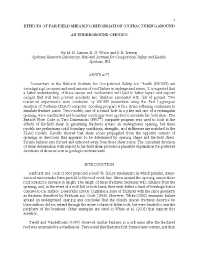Mining Publication: Effects of Far-Field Shearing Deformation on Fracturing Around an Underground Opening
Original creation date: May 2004
Researchers at the National Institute for Occupational Safety and Health (NIOSH) are investigating the causes and mechanisms of roof failure in underground mines. It is expected that a better understanding of these causes and mechanisms will lead to better layout and support designs that will help prevent accidents and fatalities associated with fall of ground. Two numerical experiments were conducted by NIOSH researchers using the Fast Lagrangian Analysis of Continua (FLAC) computer modeling program with a strain-softening continuum to simulate fracture zones. Two models, one of a round hole in a plate and one of a rectangular opening, were constructed and boundary conditions were applied to simulate far-field shear. The Particle Flow Code in Two Dimensions (PFC2D) computer program was used to look at the effects of far-field shear in generating fractures around an underground opening, but these models are preliminary until boundary conditions, strengths, and stiffnesses are matched to the FLAC models. Results showed that shear zones propagated from the opposite corners of openings in directions that appeared to be determined by opening shape and far-field stress. Tensile failures also formed and extended away from these shear zones. The consistent direction of shear deformation with respect to far-field shear provides a plausible explanation for preferred directions of shear as seen in geologic environments.
Authors: MK Larson, BG White, SR Iverson
Conference Paper - May 2004
NIOSHTIC2 Number: 20026092
Proceedings of the 39th Symposium on Engineering Geology and Geotechnical Engineering: Research to Practice, May 18-19, 2004. M. McLaughlin and R. McNearny, eds., Butte, MT: Montana Tech of the University of Montana, 2004 May; :293-307
See Also
- CFD Modeling of Spontaneous Heating in a Large-Scale Coal Chamber
- Development of Multiple Regression Functions for Performance Prediction of Gob Gas Ventholes for Sealed and Active Longwall Mines
- Diagnosing and Controlling Moisture-Sensitive Roof in Coal Mines
- The Introduction of Roof Bolting to U.S. Underground Coal Mines (1948-1960): A Cautionary Tale
- Optimizing Secondary Roof Support with the NIOSH Support Technology Optimization Program (STOP)
- Preventing Injuries Caused by Unrecognized Stone Mine Roof Beam Failures With a Pro-Active Roof Control Plan
- SPONCOM - A Computer Program for the Prediction of the Spontaneous Combustion Potential of an Underground Coal Mine
- SponCom - Spontaneous Combustion Assessment Software - 2.0
- Technique to Assess Hazards in Underground Stone Mines: the Roof Fall Risk Index (RFRI)
- Technology News 545 - NIOSH Updates Spontaneous Combustion Assessment Software
- Page last reviewed: 9/21/2012
- Page last updated: 9/21/2012
- Content source: National Institute for Occupational Safety and Health, Mining Program


 ShareCompartir
ShareCompartir
